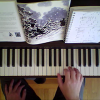Teacher, author and composer Edward Weiss has come up with a novel and intriguing method for helping his students learn the joys of musical improvisation (or improv for short) on the piano.
He's christened it Paiku—a fusion of the word piano and the Japanese poetic art of haiku. A haiku is a short poem about a present moment experience. So a Paiku is the exact same thing, only for music.
So, how exactly is Paiku played?
Paiku is a short piano piece using no more than 3 chords and lasting no longer than 2 minutes. Edward states his this compositional method allows his students to easily grasp the concept of piano improv, while at the same time creating hauntingly beautiful music in a very short period of time. And Ed says even rank beginners can master this skill with just a few days of practice.
Composing Music For More Than 14 Years
For well over a decade this musician has been in the forefront of the style called New Age Music, melodies combining the free form strains of the 60's “Age of Aquarius" movement with underlying tones of classical cadence.
Endorsed by the grand master of New Age Music himself, David Lanz—Edward Weiss has devoted his energies to bringing this wonderful musical style into the mainstream. He's now gone one giant step further with his Paiku style of composing.
Here's how this master of the piano says it's done:
“First, all we do is choose a key to play in. This can be anything from a Major chord to a minor modal. If you don't have a key in mind, no problem. Let yourself go and choose one just by playing around on the piano keyboard, allowing your inner spirit in helping you find the right sound.
“Second, begin improvising right away by using the first chord. For example, let's say I sit down at the piano and like the idea of playing something in E Major. I reach for an E Major 7 chord and this begins the improvisation.
“Last but not least, you're only allowed 3 chords to play with. For instance, in the above example I begin by playing a E Major 7 chord. The first chord determines the Key so I can play any other chord from the Key of E Major. Chords must be within the Key so I can't go outside of E Major."
Ed's main point is this: Keep it simple so you can focus on the improvisation and stay in the present.
Edward Weiss is not only a pianist/composer, but webmaster of his own online learning center: Quiescence Music. He's been helping people learn how to play piano in every stage and from every walk of life, working with students in private, in groups, and of course over the internet.
He's christened it Paiku—a fusion of the word piano and the Japanese poetic art of haiku. A haiku is a short poem about a present moment experience. So a Paiku is the exact same thing, only for music.
So, how exactly is Paiku played?
Paiku is a short piano piece using no more than 3 chords and lasting no longer than 2 minutes. Edward states his this compositional method allows his students to easily grasp the concept of piano improv, while at the same time creating hauntingly beautiful music in a very short period of time. And Ed says even rank beginners can master this skill with just a few days of practice.
Composing Music For More Than 14 Years
For well over a decade this musician has been in the forefront of the style called New Age Music, melodies combining the free form strains of the 60's “Age of Aquarius" movement with underlying tones of classical cadence.
Endorsed by the grand master of New Age Music himself, David Lanz—Edward Weiss has devoted his energies to bringing this wonderful musical style into the mainstream. He's now gone one giant step further with his Paiku style of composing.
Here's how this master of the piano says it's done:
“First, all we do is choose a key to play in. This can be anything from a Major chord to a minor modal. If you don't have a key in mind, no problem. Let yourself go and choose one just by playing around on the piano keyboard, allowing your inner spirit in helping you find the right sound.
“Second, begin improvising right away by using the first chord. For example, let's say I sit down at the piano and like the idea of playing something in E Major. I reach for an E Major 7 chord and this begins the improvisation.
“Last but not least, you're only allowed 3 chords to play with. For instance, in the above example I begin by playing a E Major 7 chord. The first chord determines the Key so I can play any other chord from the Key of E Major. Chords must be within the Key so I can't go outside of E Major."
Ed's main point is this: Keep it simple so you can focus on the improvisation and stay in the present.
Edward Weiss is not only a pianist/composer, but webmaster of his own online learning center: Quiescence Music. He's been helping people learn how to play piano in every stage and from every walk of life, working with students in private, in groups, and of course over the internet.


























